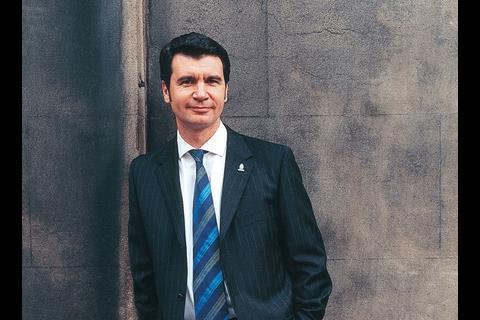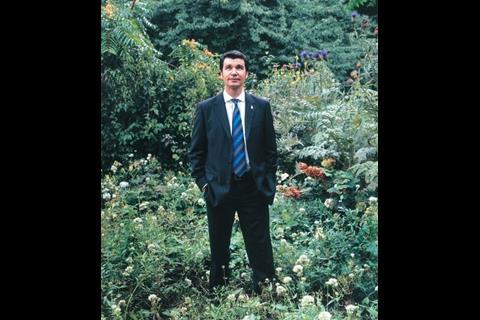The UK Green ║├╔½Ž╚╔·TV Council wants to create a road map towards a sustainable environment. Paul King, its chief executive and a man of impeccable green credentials, will be in the driving seat ŌĆō or should that be bike saddle?
Paul King is an almost perfect ambassador for creating a greener built environment. He is no raving eco-warrior, needling the decision-making classes with impossible demands. Nor is he an apologist for big business, peddling diluted greenwash in a bid to keep executives sweet. Instead, he has that modern, hard-to-categorise appeal ŌĆō casual yet smart, authoritative yet relaxed, committed without being overbearing. In short, Paul King comes across as a thoroughly nice bloke.
This appeal has paid dividends for King. During his 13 years at environmental group WWF, he managed its One Million Sustainable Homes campaign and was a key figure in turning the Code for Sustainable Homes from pipedream to reality. All of which made him a logical choice as the first chief executive of the UK Green ║├╔½Ž╚╔·TV Council (UKGBC), the campaign group for a sustainable built environment that was established last October.
The council brings together a cross-section of organisations with interest in the construction industry, from clients such as Marks & Spencer, to Arup, the Environment Agency, BRE and Cabe.
King says the UKGBC wants to build a ŌĆ£road mapŌĆØ towards a more sustainable environment in the UK. ŌĆ£The process will be identifying blockages and barriers and hopefully be in a position to pull in the people who have influence over removing those barriers,ŌĆØ explains King, who perceives these ŌĆ£barriersŌĆØ in government policy and regulation as well in the inertia within the industry or among building occupiers.
Fortunately, the UKGBC already has the ear of policy makers. ŌĆ£Quite recently, the Department for Communities and Local Government approached me to form a steering group to look at, in effect, a code for non-domestic sustainable buildings,ŌĆØ says King. His response was to pull together the shared expertise of the UKGBCŌĆÖs members to see what such a code could look like ŌĆō all for free. ŌĆ£They [the communities department] were a bit taken aback by these companies saying they wanted to work together for no charge,ŌĆØ laughs King.
But there is a serious side to this generosity. ŌĆ£We want to demonstrate to the government that we are up for this agenda and share the governmentŌĆÖs level of ambition,ŌĆØ says King. ŌĆ£But we want to be more equal partners in this process and would like this to be a more shared dialogue about the best way of achieving these targets.ŌĆØ
King hopes those targets will be the same as the Code for Sustainable Homes ŌĆō in other words, zero-carbon non-housing by 2016.
ŌĆ£I would be surprised if that hadnŌĆÖt entered the head of ministers,ŌĆØ he says.
However, this work does present some distinct challenges, not least coming up with a standard that caters for the wide variety of non-domestic building types. ŌĆ£One of the things we have got to figure out is how to take into account the many different building types and the processes these house, but not end up with a level of complexity that confuses the hell out of everybody,ŌĆØ he says.
We have got to figure out how to take into account the many different building types and processes, but not end up with a level of complexity that confuses the hell out of everybody
There would ŌĆ£probablyŌĆØ be 10 types of building and ŌĆ£lotsŌĆØ of different uses, each of which would have a marked but different effect on energy consumption. With this in mind, the UKGBC is trying to keep things simple by separating the building from its end use. Designers would need to first reduce the energy use in the building, then focus on optimising energy consumption for specific users. Working through this process will take four to five months and, according to King, the communities department would like to have a consultation paper out by the end of this year.
The UKGBC has also been asked by the department to review the environmental assessment tool for non-dwellings, BREEAM, which it is doing with the blessing of the toolŌĆÖs owner, BRE. King wants the UKGBC to offer a range of approved toolkits for the industry to use without ŌĆ£reinventing the wheelŌĆØ. The idea is to get feedback from UKGBC members to see if BREEAM can be improved in any way.
There is a precursor to this that suggests the wheel will stay in pretty much its traditional form: in his last job at WWF, King was very critical of the governmentŌĆÖs original proposals for the Code for Sustainable Homes, which involved getting rid of EcoHomes, the environmental assessment tool for housing.
In the end, EcoHomes was adapted for the code and King hopes the same will happen with BREEAM and a code for non-dwellings. He says: ŌĆ£There is a very strong logic to say, letŌĆÖs look at what we want, see if BREEAM has something to offer and then tweak it to suit.ŌĆØ
The next target for his attention could be the widely adopted council requirement for new schemes to generate 10% or more of their power from on-site renewable energy.
ŌĆ£I think it can have unintended and perverse consequences,ŌĆØ King warns.
ŌĆ£ThereŌĆÖs the danger that all the emphasis will go on meeting that renewables target, and it will be seen as a tax which has to be swallowed regardless of the efficiency of the building it is being put on.ŌĆØ
But the focus of UKGBC isnŌĆÖt all new build ŌĆō King has set his sights firmly on existing building stock. He reckons the carbon emissions from existing housing will need to be reduced by more than the governmentŌĆÖs reduction target of 60% by 2050 to compensate for new development, which is a tall order.
King likes the idea of making it much more attractive for people to improve the energy efficiency of their homes. He says: ŌĆ£We have got to find a way of unlocking the market and make it a no-brainer for people to improve their homes.ŌĆØ
The government mandated that everyone had to switch over to digital TV, so why not mandate that all homes have to be brought up to a certain level of energy efficiency?
One possible market solution is to get financial institutions to offer home improvement loans for energy-saving measures, with the loan paid off by the energy savings made. Reductions in council tax could also play a part. King cites a pilot project in Braintree, Essex, which resulted in ŌĆ£phenomenal take-upŌĆØ after the council collaborated with British Gas to offer a ┬Ż100 reduction in council tax for installing cavity wall insulation.
ŌĆ£There are some incentives that people psychologically respond to much more than others, and the idea of getting money off your council tax is much more attractive than applying for a grant,ŌĆØ says King. ŌĆ£Undoubtedly, that will be a conversation we will be having with the government.ŌĆØ
If a market-based solution doesnŌĆÖt work, King doesnŌĆÖt shy away from compulsion. ŌĆ£If those things donŌĆÖt work, you have to look at some mandatory measures,ŌĆØ he says.
ŌĆ£The government mandated that everyone within a certain period of time had to switch over to digital TV, so why not mandate that all homes have to be brought up to a certain level of energy efficiency?ŌĆØ
One possibility could be to make people upgrade their homes according to the recommendations on the energy performance certificates.
Whatever the details of these initiatives may be, prepare for big changes rather than incremental steps. ŌĆ£Both environmentally and economically, there are benefits from a step change in the way things are done,ŌĆØ says King.
He has faith in the industry can rise to these challenges, pointing to the example of the housebuilders. ŌĆ£I think the housebuilders should be recognised for how they have begun to respond to the zero-carbon challenge. They have immediately started to think how they will achieve level five and level six,ŌĆØ he says.
The housebuilders may have started talking KingŌĆÖs language; itŌĆÖs now up to the rest of the industry, and everybody else, to follow suit.
Postscript
For more on sustainable construction, visit





























No comments yet